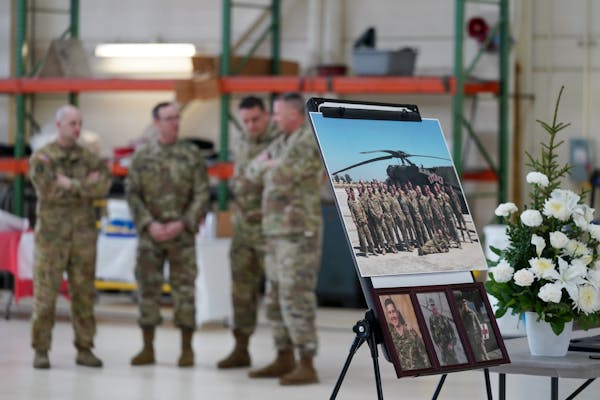NORTH FORT HOOD, Texas – Their silence was expected, but that did not make it any less jarring.
Inside the North Fort Hood Chapel on Sunday afternoon, the first sergeant from the Minnesota National Guard shouted out the final roll call.
"Chief Warrant Officer 2 Rogers?"
No answer.
"Chief Warrant Officer 2 James Rogers?"
No answer.
Behind the first sergeant stood the proof of the silence, three helmets on top of three rifles, the soldiers' universal plain memorial for fallen comrades in honor of the three soldiers who died last week in a helicopter crash back in Minnesota. In front of him were hundreds of Minnesota National Guard soldiers, about to deploy to the Middle East. They stood at attention, arms at their sides.
"Chief Warrant Officer 2 James. A. Rogers Jr.?"
Again, no answer.
In the second row, Sgt. Deonte Haynes put his head down and wiped away a tear. A crew chief in the same battalion, he didn't know the three soldiers who died Thursday – the 28-year-old Rogers, of Winsted; Charles P. Nord, 30, of Perham; and Kort M. Plantenberg, 28, of Avon. But that didn't matter. Haynes knows these helicopters. He's flown so many of those route maintenance flights, like the one that ended in a fatal crash Thursday afternoon in Stearns County. And he's about to head to the same part of the world that those three soldiers just returned from in May. It will be Haynes' first deployment. Sunday was his first memorial ceremony.
"Chief Warrant Officer 2 Nord?" the first sergeant shouted. "Chief Warrant Officer 2 Charles Nord? … Chief Warrant Officer 2 Charles P. Nord?"
For these soldiers about to head to the Middle East for a nine-month deployment, Thursday's accident and Sunday's memorial made the upcoming Minnesota National Guard deployment that much more real.
"The roll call, that's what gets most of us,'' he said. "That's what got me.''
"Sgt. Plantenberg?" the first sergeant shouted. "Sgt. Kort Plantenberg?" "Sgt. Kort M. Plantenberg?"
Specialist Nicole Cavanaugh, 20, is a helicopter mechanic based out of the same Army aviation support facility in St. Cloud as the three fallen soldiers. She'd become close friends with Plantenberg over the summer. She was nervous about her upcoming deployment and Plantenberg, who'd just returned from his, helped calm her nerves. They talked about his beloved long-haired German shepherd and about his latest excursions on his new bass boat.
For the first couple of days after the crash, she didn't know the names of the dead. The military kept it all confidential until families were notified. Cavanaugh sent Plantenberg a note on Facebook; no answer.
Then she heard that the helicopter that crashed didn't have a hoist system, which meant there was a good chance it was the same helicopter that she worked on as a ground mechanic.
Then she learned her friend was one of the dead, and that the tail number of the helicopter that crashed was 967, the same tail number that she'd been assigned to back in St. Cloud.
"It had just come back from Corpus Christi, where it was fixed up, completely redone," Cavanaugh said. "It was the bird I watched over."
Even though she hadn't worked on that aircraft since coming to Fort Hood in October, she was still left shaken.
"In my head I have a sick feeling," she said. "And a sick feeling in my gut. I won't eat for a while. He was almost too good. He was very wholehearted, just huge inside. He was quiet, but he was respected."
After the final roll call came a 21-gun salute outside the chapel. Then taps.
The soldiers walked to the front of the chapel, kneeling in tribute at each of the silent sentinels: A helmet, a rifle, a photograph, an empty pair of combat boots.
Soon they would board planes to the Middle East. They still had their mission.
Reid Forgrave covers Minnesota and the Upper Midwest for the Star Tribune.
DFL state senator charged with first-degree burglary after breaking into stepmother's home

Ideological divide threatens Anoka-Hennepin schools budget, spurs student protest

Souhan: Wolves fans made Game 1 special. Now bring on Game 2.

